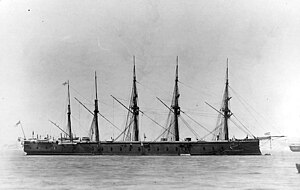HMS Northumberland (1866)

Northumberland in her original 5-masted configuration
|
|
| History | |
|---|---|
|
|
|
| Name: | HMS Northumberland |
| Namesake: | Northumberland |
| Ordered: | 2 September 1861 |
| Builder: | Millwall Iron Works, Millwall, London |
| Cost: | £444,256 |
| Laid down: | 10 October 1861 |
| Launched: | 17 April 1866 |
| Completed: | 8 October 1868 |
| Commissioned: | October 1868 |
| Decommissioned: | 1898 |
| Out of service: | Hulked, 1909 |
| Renamed: |
|
| Reclassified: | Training ship, 1898 |
| Struck: | 1927 |
| Fate: |
|
| General characteristics (as completed) | |
| Class and type: | Minotaur-class armoured frigate |
| Displacement: | 10,584 long tons (10,754 t) |
| Length: | 400 ft 4 in (122.0 m) p/p |
| Beam: | 59 ft 5 in (18.1 m) |
| Draught: | 27 ft 9 in (8.5 m) |
| Installed power: |
|
| Propulsion: | 1 shaft, 1 Trunk steam engine |
| Sail plan: | 5-masted |
| Speed: | 14 knots (26 km/h; 16 mph) |
| Range: | 2,825 nmi (5,232 km; 3,251 mi) at 10 knots (19 km/h; 12 mph) |
| Complement: | 800 |
| Armament: | |
| Armour: | |
HMS Northumberland was the last of the three Minotaur-class armoured frigates built for the Royal Navy during the 1860s. She had a different armour scheme and heavier armament than her sister ships, and was generally regarded as a half-sister to the other ships of the class. The ship spent her career with the Channel Fleet and occasionally served as a flagship. Northumberland was placed in reserve in 1890 and became a training ship in 1898. She was converted into a coal hulk in 1909 and sold in 1927, although the ship was not scrapped until 1935.
The Minotaur-class armoured frigates were essentially enlarged versions of the ironclad HMS Achilles with heavier armament, armour, and more powerful engines. They retained the broadside ironclad layout of their predecessor, but their sides were fully armoured to protect the 50 guns they were designed to carry. Their plough-shaped ram was also more prominent than that of Achilles.
Northumberland was 400 feet 4 inches (122.0 m) long between perpendiculars and had a beam of 58 feet 5 inches (17.8 m) and a draught of 27 feet 9 inches (8.5 m). The ship displaced 10,584 long tons (10,754 t) and had a tonnage of 6,621 tons burthen. Her hull was subdivided by 15 watertight transverse bulkheads and had a double bottom underneath the engine and boiler rooms. The ship was considered "a steady gun platform, able to maintain her speed in a seaway and satisfactory in manoeuvre". She was authorized a crew of 705 officers and enlisted men, but actually carried 800 men.
...
Wikipedia
